
EFFECTIVE APRIL 2018
HardiePanel
®
Vertical Siding
GENERAL REQUIREMENTS:
• These instructions to be used for single family installations only. **For Commercial / Multi-Family installation
requirements go to www.JamesHardieCommercial.com
• HardiePanel
®
vertical siding can be installed over braced wood or steel studs, 20 gauge (33 mils) minimum to 16
gauge (54 mils) maximum, spaced a maximum of 24 in o.c. or directly to minimum 7/16 in thick OSB sheathing.
See General Fastening Requirements. Irregularities in framing and sheathing can mirror through the finished
application. Correct irregularities before installing siding.
• Information on installing James Hardie products over non-nailable substrates (ex: gypsum, foam,etc.) can be
located in JH Tech Bulletin 19 at www.jamehardie.com
• A water-resistive barrier is required in accordance with local building code requirements. The water-resistive
barrier must be appropriately installed with penetration and junction flashing in accordance with local building
code requirements. James Hardie will assume no responsibility for water infiltration. James Hardie does
manufacture HardieWrap
®
Weather Barrier, a non-woven non-perforated housewrap¹, which complies with
building code requirements.
• When installing James Hardie products all clearance details in figs. 3, 5, 6, 7, 8, 9, 10 & 11 must be followed.
• Adjacent finished grade must slope away from the building in accordance with local building codes - typically a
minimum of 6 in. in the first 10 ft.
• Do not use HardiePanel lap siding in Fascia or Trim applications.
• Do not install James Hardie products, such that they may remain in contact with standing water.
• HardiePanel vertical siding may be installed on flat vertical wall applications only.
• DO NOT use stain, oil/alkyd base paint, or powder coating on James Hardie
®
Products.
• For larger projects, including commercial and multi-family projects, where the span of the wall is significant in
length, the designer and/or architect should take into consideration the coefficient of thermal expansion and
moisture movement of the product in their design. These values can be found in the Technical Bulletin “Expansion
Characteristics of James Hardie
®
Siding Products” at www.jameshardie.com.
• James Hardie Building Products provides installation/wind load information for buildings with a maximum
mean roof height of 85 feet. For information on installations above 60 feet, please contact JH technical
support.
IMPORTANT: FAILURE TO FOLLOW JAMES HARDIE WRITTEN INSTALLATION INSTRUCTIONS AND COMPLY WITH APPLICABLE BUILDING CODES MAY VIOLATE LOCAL LAWS, AFFECT
BUILDING ENVELOPE PERFORMANCE AND MAY AFFECT WARRANTY COVERAGE. FAILURE TO COMPLY WITH ALL HEALTH AND SAFETY REGULATIONS WHEN CUTTING AND INSTALLING
THIS PRODUCT MAY RESULT IN PERSONAL INJURY. BEFORE INSTALLATION, CONFIRM YOU ARE USING THE CORRECT HARDIEZONE® PRODUCT INSTRUCTIONS BY VISITING
HARDIEZONE.COM OR CALL 1-866-942-7343 (866-9-HARDIE)
Visit jameshardiepros.com for the most recent version.
SMOOTH | CEDARMILL
©
| STUCCO | SIERRA 8
HS1236 P1/3 04/18
Figure 1
Figure 2
Figure 3
Caulk Joint
leave appropriate gap between
panels, then caulk*
water-resistive barrier
2 x 4 stud
“H” Joint
water-resistive barrier
2 x 4 stud
Batten Joint
water-resistive barrier
2 x 4 stud
Figure 4
Recommendation: When
installing Sierra 8, provide
a double stud at panel
joints to avoid nailing
through grooves.
moderate contact
water-resistive
barrier
HardiePanel
vertical siding
Keep nails
3/8in min.
from panel
edges
Keep fasteners 2in
away from corners
3/8in
sheathing
upper panel
1/4" gap
Z-flashing
Do not
Caulk
lower
panel
upper panel
1/4" gap
Z-flashing
Do not
Caulk
lower
panel
decorative
band board
water-resistive
barrier
water-resistive
barrier
INSTALLATION:
Fastener Positioning
Joint Treatment
(Caulking Joints is
not applicable to
ColorPlus
®
Finish)
*Apply caulk in accordance with caulk manufacturer’s written application instructions.
¹For additional information on HardieWrap™ Weather Barrier, consult James Hardie at 1-866-4Hardie or www.hardiewrap.com
**James Hardie recommends installing a rainscreen (an air gap) between the HardiePanel siding and the water-resistive barrier as a best practice.
James Hardie recommends that you consult your design professional if you have questions regarding the use of rainscreen on your single family project.
Position fasteners 3/8" from panel edges and no closer
than 2in away from corners. Do not nail into corners.
HardiePanel Vertical Siding Installation
• Framing must be provided at horizontal and vertical
edges for nailing.
• HardiePanel vertical siding must be joined on stud.
• Double stud may be required to maintain minimum
edge nailing distances.
• Vertical Joints - Install panels in moderate contact (fig. 1),
alternatively joints may also be covered with battens,
PVC or metal jointers or caulked (Not applicable to
ColorPlus
®
Finish) (fig. 2).
• Horizontal Joints - Provide Z-flashing at all horizontal
joints (fig. 3).
Store flat and keep dry and covered prior to
installation. Installing siding wet or saturated may
result in shrinkage at butt joints. Carry planks on
edge. Protect edges and corners from breakage.
James Hardie is not responsible for damage caused
by improper storage and
handling of the
product.
OUTDOORS
1. Position cutting station so that airflow blows dust away from the
user and others near the cutting area.
2. Cut using one of the following methods:
a. Best: Circular saw equipped with a HardieBlade
®
saw blade
and attached vacuum dust collection system. Shears
(manual, pneumatic or electric) may also be used, not
recommended for products thicker than 7/16 in.
b. Better: Circular saw equipped with a dust collection feature
(e.g. Roan
®
saw) and a HardieBlade saw blade.
c. Good: Circular saw equipped with a HardieBlade saw blade.
INDOORS
DO NOT grind or cut with a power saw indoors. Cut using shears (manual, pneumatic or
electric) or the score and snap method, not recommended for products thicker than 7/16 in.
- DO NOT dry sweep dust; use wet dust suppression or vacuum to collect dust.
- For maximum dust reduction, James Hardie recommends using the “Best” cutting
practices. Always follow the equipment manufacturer’s instructions for proper operation.
- For best performance when cutting with a circular saw, James Hardie recommends
using HardieBlade
®
saw blades.
- Go to jameshardiepros.com for additional cutting and dust control recommendations.
CUTTING INSTRUCTIONS
STORAGE & HANDLING:
IMPORTANT: The Occupational Safety and Health Administration (OSHA) regulates workplace exposure to silica dust. For construction sites, OSHA has deemed
that cutting fiber cement with a circular saw having a blade diameter less than 8 inches and connected to a commercially available dust collection system per
manufacturer’s instructions results in exposures below the OSHA Permissible Exposure Limit (PEL) for respirable crystalline silica, without the need for additional
respiratory protection.
If you are unsure about how to comply with OSHA silica dust regulations, consult a qualified industrial hygienist or safety professional, or contact your James
Hardie technical sales representative for assistance. James Hardie makes no representation or warranty that adopting a particular cutting practice will assure
your compliance with OSHA rules or other applicable laws and safety requirements.

Figure 3
Roof to Wall
Figure 4
Horizontal Flashing
Figure 5
Kickout Flashing
Figure 6
Slabs, Path, Steps to Siding
Figure 7
Deck to Wall
Figure 8
Ground to Siding
Figure 9
Gutter to Siding
Figure 12
Drip Edge
Figure 13
Block Penetration
Figure 14
Valley/Shingle Extension
Min. 1 in.
Min.
1 in.
Min. 6 in.
1in.
Z-Flashing
Z-Flashing
Z-Flashing
Min. 1 in.
Min. ¼ in.
Do not caulk
Extend shingles
at least 1 in.
out from the
fascia when
gutters are
present
As required
by IRC code
min 4 in. x 4 in.
Min. ¼ in.
Do not caulk
CLEARANCE AND FLASHING REQUIREMENTS
HardiePanel
®
Vertical Siding
HS1236 P2/3 04/18
Figure 10
Sheltered Areas
Figure 11
Mortar/Masonry
Min. ¼ in.
Min. ¼ in.
Min. ½ in.
Z-Flashing
Z-Flashing
L-Flashing
GENERAL FASTENING REQUIREMENTS
Fasteners must be corrosion resistant, galvanized, or stainless steel. Electro-galvanized
are acceptable but may exhibit premature corrosion. James Hardie recommends the
use of quality, hot-dipped galvanized nails. James Hardie is not responsible for the
corrosion resistance of fasteners. Stainless steel fasteners are recommended when
installing James Hardie
®
products near the ocean, large bodies of water, or in very
humid climates.
Manufacturers of ACQ and CA preservative-treated wood recommend spacer materials
or other physical barriers to prevent direct contact of ACQ or CA preservative-treated
wood and aluminum products. Fasteners used to attach HardieTrim Tabs to preserva-
tive-treated wood shall be of hot dipped zinc-coated galvanized steel or stainless steel
and in accordance to 2009 IRC R317.3 or 2009 IBC 2304.9.5
• Consult applicable product evaluation or listing for correct fasteners type and
placement to achieve specified design wind loads.
• NOTE: Published wind loads may not be applicable to all areas where Local Building
Codes have specific jurisdiction. Consult James Hardie Technical Services if you are
unsure of applicable compliance documentation.
• Drive fasteners perpendicular to siding and framing.
• Fastener heads should fit snug against siding (no air space).
• NOTE: Whenever a structural member is present, HardiePlank should be fastened with
even spacing to the structural member. The tables allowing direct to OSB or plywood
should only be used when traditional framing is not available.
PNEUMATIC FASTENING
James Hardie products can be hand nailed
or fastened with a pneumatic tool.
Pneumatic fastening is highly recommend-
ed. Set air pressure so that the fastener is
driven snug with the surface of the siding.
A flush mount attachment on the
pneumatic tool is recommended. This will
help control the depth the nail is driven. If
setting the nail depth proves difficult,
choose a setting that under drives the nail.
(Drive under driven nails snug with a
smooth faced hammer - Does not apply for
installation to steel framing).
SNUG FLUSH
ALUMINUM
CLIPPED
STAPLES
HEAD NAILS
FASTENERS
UNDER
DRIVE
OVER
DRIVE
SLANT
IF, THEN IF, THEN ADDITIONAL NAIL
WOOD
FRAME
HAMMER
FLUSH
REMOVE &
REPLACE
COUNTERSINK
& FILL
STEEL
FRAME
FACE
NAIL
DO NOT DO NOT
DO NOT USE
AL

HardiePanel
®
Vertical Siding
PAINTING JAMES HARDIE
®
SIDING AND TRIM PRODUCTS WITH COLORPLUS
®
TECHNOLOGY
When repainting ColorPlus products, James Hardie recommends the following regarding surface preparation and topcoat application:
• Ensure the surface is clean, dry, and free of any dust, dirt, or mildew
• Repriming is normally not necessary
• 100% acrylic topcoats are recommended
• DO NOT use stain, oil/alkyd base paint, or powder coating on James Hardie
®
Products.
• Apply finish coat in accordance with paint manufacturers written instructions regarding coverage, application methods, and application temperature
• DO NOT caulk nail heads when using ColorPlus products, refer to the ColorPlus touch-up section
COLORPLUS
®
TECHNOLOGY CAULKING, TOUCH-UP & LAMINATE
• Care should be taken when handling and cutting James Hardie
®
ColorPlus
®
products. During installation use a wet soft cloth or soft brush to gently wipe off any
residue or construction dust left on the product, then rinse with a garden hose.
• Touch up nicks, scrapes and nail heads using the ColorPlus
®
Technology touch-up applicator. Touch-up should be used sparingly.
If large areas require touch-up, replace the damaged area with new HardiePlank
®
lap siding with ColorPlus
®
Technology.
• Laminate sheet must be removed immediately after installation of each course.
• Terminate non-factory cut edges into trim where possible, and caulk. Color matched caulks are available from your ColorPlus
®
product dealer.
• Treat all other non-factory cut edges using the ColorPlus Technology edge coaters, available from your ColorPlus product dealer.
Note: James Hardie does not warrant the usage of third party touch-up or paints used as touch-up on James Hardie ColorPlus products.
Problems with appearance or performance arising from use of third party touch-up paints or paints used as touch-up that are not James Hardie touch-up will not be covered
under the James Hardie ColorPlus Limited Finish Warranty.
PAINTING
CAULKING
For best results use an Elastomeric Joint Sealant complying with ASTM C920 Grade NS,
Class 25 or higher or a Latex Joint Sealant complying with ASTM C834. Caulking/Sealant
must be applied in accordance with the caulking/sealant manufacturer’s written instructions.
Note: some caulking manufacturers do not allow "tooling".
DO NOT use stain, oil/alkyd base paint, or powder coating on James Hardie
®
Products. Factory-primed James Hardie products must be painted within 180 days of installation.
100% acrylic topcoats are recommended. Do not paint when wet. For application rates refer to paint manufacturers specifications. Back-rolling is recommended if the siding
is sprayed.
CUT EDGE TREATMENT
Caulk, paint or prime all field cut edges. James Hardie touch-up kits are required to
touch-up ColorPlus products.
HS1236 P3/3 04/18
Product warranties, safety information and additional installation
information are available at jameshardiepros.com
© 2018 James Hardie Building Products, Inc. All rights reserved TM, SM and ®
denote trademarks or registered trademarks of James Hardie Technology Limited.
WARNING: This product can expose you to chemicals including respirable crystalline silica, which is known to the State of California to cause cancer. For more information go to P65Warnings.ca.gov.
RECOGNITION: In accordance with ICC-ES Evaluation Report ESR-2290, HardiePlank® lap siding is recognized as a suitable alternate to that specified in: the 2006,2009,&2012 International Residential Code for One- and Two-Family
Dwellings, and the 2006, 2009, & 2012 International Building Code,. HardiePlank lap siding is also recognized for application in the following: City of Los Angeles Research Report No. 24862, State of Florida listing FL#889, Dade County,
Florida NOA No. 02-0729.02, U.S. Dept. of HUD Materials Release 1263c, Texas Department of Insurance Product Evaluation EC-23, City of New York MEA 223-93-M, and California DSA PA-019. These documents should also be consulted
for additional information concerning the suitability of this product for specific applications.
DANGER: May cause cancer if dust from product is inhaled. Causes damage to lungs and respiratory system through prolonged or repeated inhalation of dust from product. Refer to the current product Safety Data Sheet before use.
The hazard associated with fiber cement arises from crystalline silica present in the dust generated by activities such as cutting, machining, drilling, routing, sawing, crushing, or otherwise abrading fiber cement, and when cleaning
up, disposing of or moving the dust. When doing any of these activities in a manner that generates dust you must (1) comply with the OSHA standard for silica dust and/or other applicable law, (2) follow James Hardie cutting
instructions to reduce or limit the release of dust; (3) warn others in the area to avoid breathing the dust; (4) when using mechanical saw or high speed cutting tools, work outdoors and use dust collection equipment; and (5) if no
other dust controls are available, wear a dust mask or respirator that meets NIOSH requirements (e.g. N-95 dust mask). During clean-up, use a well maintained vacuum and filter appropriate for capturing fine (respirable) dust or use
wet clean-up methods - never dry sweep.
SILICA WARNING
-
 1
1
-
 2
2
-
 3
3
James Hardie 217950 Installation guide
- Type
- Installation guide
- This manual is also suitable for
Ask a question and I''ll find the answer in the document
Finding information in a document is now easier with AI
Related papers
-
James Hardie 617601 Installation guide
-
James Hardie 216651 User manual
-
James Hardie 6000522 Installation guide
-
James Hardie 217864 User manual
-
James Hardie 974131 Installation guide
-
HardiePlank 6851131 Installation guide
-
James Hardie 615980 Installation guide
-
James Hardie 215518 Installation guide
-
Unbranded 972381 Installation guide
-
Unbranded 6480381 Installation guide
Other documents
-
 Floating Glass Shelves R842 Installation guide
Floating Glass Shelves R842 Installation guide
-
König SAT-MH15/2 Datasheet
-
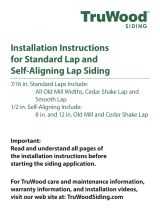 TruWood 30193 Installation guide
TruWood 30193 Installation guide
-
 TruWood 7LOM8 Installation guide
TruWood 7LOM8 Installation guide
-
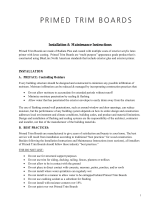 CMPC 280552 Installation guide
CMPC 280552 Installation guide
-
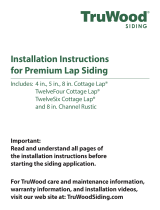 TruWood 1LOM5CL12 Installation guide
TruWood 1LOM5CL12 Installation guide
-
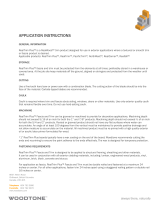 Woodtone 284446 Installation guide
Woodtone 284446 Installation guide
-
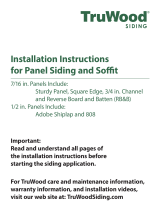 TruWood 7POMSP Operating instructions
TruWood 7POMSP Operating instructions
-
 TruWood 50248 Operating instructions
TruWood 50248 Operating instructions
-
Bullet Tools 620 Specification










